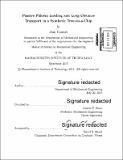Passive phloem loading and long-distance transport in a synthetic tree-on-a-chip
Author(s)
Comtet, Jean
DownloadFull printable version (4.489Mb)
Other Contributors
Massachusetts Institute of Technology. Department of Mechanical Engineering.
Advisor
Anette E. Hosoi.
Terms of use
Metadata
Show full item recordAbstract
According to the Munch mechanism, vascular plants rely on osmotic pressure gradients to export sugars from regions of synthesis (mature leaves) to sugar sinks (roots, fruits). A crucial step in this process is the loading of sugars from photosynthetic cells to the export conduit (the phloem). In this thesis, we developed a synthetic microfluidic osmotic pump mimicking the mechanism of passive phloem loading, where sugars are transported by diffusion from a sugar reservoir to the phloem. This design allows the development of steady flow over several hours. We show that in our system, phloem concentration is set by a relative balance between loading by diffusion from the source and export by convection through the phloem, via a single nondimensional system-scale Peclet number that we call the flushing number. For large flushing numbers, export is limited by diffusion from the source, and flow rates scale weakly with transport resistance. For low flushing numbers, export is limited by convection through the phloem and phloem concentration is close to that of the source, leading to efficient export of water and sugars. In plants, passive phloem loading is used predominantly by trees. We show that the hydrostatic pressures developed in our synthetic system can reach up to ten bars and are thus compatible with the pressures expected to drive long-distance transport in large trees. Moreover, we show that the regime of efficient export in passive loaders is more accessible to plants with large transport resistances, providing a rational for the use of the passive loading mechanism by most tree species.
Description
Thesis: S.M., Massachusetts Institute of Technology, Department of Mechanical Engineering, 2015. Cataloged from PDF version of thesis. Includes bibliographical references (pages 45-46).
Date issued
2015Department
Massachusetts Institute of Technology. Department of Mechanical EngineeringPublisher
Massachusetts Institute of Technology
Keywords
Mechanical Engineering.